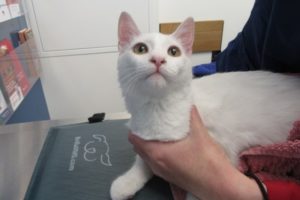
This month we are profiling a lovely white 3yr old cat by the name of Charlotte. Just about a year ago she started having some odd behaviors that happened while she was sleeping. She would tense up or twitch, sometimes fall on her side with her tongue sticking out, then wake up, look around and go back to sleep. The episodes were very short lived, about 3 seconds according to the owner, and in between episodes, Charlotte was active, eating and eliminating normally.
Charlotte was examined at Hawthorne Hills Veterinary Hospital and full blood work plus urinalysis were evaluated. Charlotte was diagnosed with a mild heart murmur, but there was no other indication of underlying disease causing these episodes. The behavior fell within the realm of a seizure disorder, of which there are a number. It wasn’t clear, but after we discussed the symptoms with a local neurologist, Charlotte was given a presumptive diagnosis of a form of epilepsy. Several other considerations were a REM Sleep Disorder, and a newer type of seizure in cats called FARS – Feline Audiogenic Reflex Seizures (however, these are much more likely in a geriatric cat).
Over time, the events starting occurring a bit more frequently, and with more severity. Medication to address the seizures was discussed. Medication to control seizures requires a period of days to weeks for the patient to adjust to the medication, and not all pets respond the same, so ‘trial and error’ is often needed. Keppra (Levetiracetam) is one medication that is very effective in cats, especially the FARS type seizures, and does not require blood monitoring. However, the medication must be given every 8 hours and that can prove to be challenging for pet owners based on their work schedule and other life commitments. We elected to start Charlotte on Phenobarbital. This medication can be given every 12 hours, but does require some regular monitoring of blood levels.
Despite starting Charlotte on the Phenobarbital, she continued to have periodic episodes. At then, end of last year, Charlotte had a significant event that resulted in an injury to her tail. Dr. Robin Riedinger examined Charlotte and with the benefit of a radiograph (x-ray), confirmed that Charlotte had broken a vertebra in her tail, about half way down the length of the tail. This was quite unusual.
 Surprisingly, many tail fractures in cats can heal without intervention presuming that the nerves and blood supply are still intact. The owner, understandably, was worried that another seizure could lead to more damage to the tail, or a greater injury of some sort. So, we opted to place a splint on Charlotte’s tail to stabilize the fracture, allow the body to heal the area while protecting it from further injury.
Surprisingly, many tail fractures in cats can heal without intervention presuming that the nerves and blood supply are still intact. The owner, understandably, was worried that another seizure could lead to more damage to the tail, or a greater injury of some sort. So, we opted to place a splint on Charlotte’s tail to stabilize the fracture, allow the body to heal the area while protecting it from further injury.
We created a light weight splint using a plastic syringe casing for stability. The splint had to be changed several times over the next month, but Charlotte was a trooper, letting us change the bandaging without any sedation. At the end of a month, the tail bones felt stable, there was no pain when we were handling her tail, and Charlotte was able to use her tail normally. It had healed well.
During the time that Charlotte’s tail was in the splint, we increased her dose of Phenobarbital with the goal of eliminating future seizures. The medication can make cats sleepy for 10-14 days was they adjust to the higher dose, and this really helped us keep her quiet while the splint was on. We’ll continue to monitor her periodically, and we are happy to report that Charlotte has been doing well on the higher dose of medication and has a great prognosis going forward.
Guidelines For Seizure Care:
- Keep records – date, time, length of event, characteristics (what exactly happened), changes that led up to the seizure (last 24 hours), and how long it took for your pet to recover and get back to normal
- Seek veterinary care – at a minimum your veterinarian should know about the seizure, do a full physical exam, collect blood, urine, and fecal samples to rule out other diseases and to get a baseline in case the events progress or your pet needs to go on medication
- Try to get a video of the event if possible as this can be helpful versus just trying to describe what you saw
- Many mild seizures are not an emergency even though they can be alarming and worrisome
- If your pet experiences a seizure, do your best to keep them safe from falling down stairs, or getting trapped under furniture; be careful around their mouth as you can get bit inadvertently
- Seizures that are full grand mal type, last longer than 5 minutes, or pets who are experiencing multiple seizures in a short time, should all be addressed immediately – call your vet or seek veterinary urgent or emergency care depending on where you are and what services might be available
- Pets who have infrequent seizures, and recover from the event fairly quickly without ongoing symptoms, likely do not need medication
- Pets who experience more than one seizure event per month, and especially if happening multiple times per month, likely benefit from medication.
- Consult your veterinarian and/or schedule a consultation with a veterinary neurologist to make the best decisions for your pet. Seizure disorders can progress over time, and earlier intervention may be best for your pet.
If you have questions as to your cat’s care or behavior, please schedule an appointment today. We are here to help.
 For more information on Seizures in Cats:
For more information on Seizures in Cats:
VeterinaryPartner.com: Seizure Disorders in Cats
iCatCare.org: Feline Audiogenic Reflex Seizures
VeterinaryPartner.com: Seizure and Convulsion First Aid Kit
VeterinaryPartner.com: Hyperesthesia Syndrome in Cats
Texas A&M Veterinary Medicine: Sleeping Disorders in Animals
ECats, Feline Medicine & Surgery: YouTube Video of Cat REM Sleep Disorder



